|
Smith & Wesson is a name which has
been synonymous with double action revolvers for well over a
century. They are known all over the world for producing some of
the finest examples of the double action revolver ever made. In
1935 S&W introduced the world to the .357 magnum cartridge,
chambering it in their large frame that would be later known as
the N frame. Twenty years later, S&W chambered the powerful
.357 magnum in their medium-sized K frame, which became an
instant hit with the shooting public, and peace officers in
particular. In the early 1970s, S&W endeared itself to
shooters with the introduction of stainless steel K-framed .357
magnum sixguns; the fixed-sighted Model 65 and the
adjustable-sighted Model 66. These two revolvers proved to be a
pair of the most popular duty sidearms ever with uniformed law
enforcement officers. They were accurate, dependable, and handy,
but prone to loosen up a bit with heavy use. In 1980, S&W
introduced a very slightly beefed up medium frame size, calling
it the L frame. These new sixguns had a little more steel in
critical areas, and wore heavy full-underlugged barrels.
Recently, Smith & Wesson has discontinued
the Models 65 and 66 in favor of two new L-framed revolvers,
calling them the Models 619 and 620. The 619 replaces the
fixed-sighted Model 65, while the 620 replaces the
adjustable-sighted Model 66.
While maintaining the handy profile of the
earlier K-framed sixguns, the new models are more than just
slightly beefier Models 65 and 66 revolvers. The most apparent
change is that the new guns are now seven-shooters instead of
six-shooters. The slightly larger cylinder allows for an extra
chamber. One more cartridge in the cylinder may or may not be of
importance. However, on the older weapons, the cylinder bolt
notches were cut directly over each chamber. Going to a
seven-shot cylinder allowed the bolt notches to be placed
between the chambers, effectively strengthening the chamber
walls at that point. The barrels on the Models 619 and 620
are of S&W’s new two-piece design, having the barrel
contained within an outer shroud. It is reminiscent of, but not
identical to, the Dan Wesson barrel design, but it is not
user-changeable. It would theoretically allow for a lower cost
barrel replacement should one ever become necessary, and the
design can also produce very good accuracy if set up correctly.
The Models 619 and 620 both wore very even barrel/cylinder gaps,
measuring .0035 inch. That is about what a good barrel/cylinder
gap should measure. The new Model
60 .357 that I tested a few months ago also had a
two-piece barrel, but the barrel/cylinder gap on that revolver
measured a bit over .007, which is larger than I like. The
Models 619 and 620 both wear four-inch barrels, and weigh in at
37.4 and 37 ounces, respectively. I attribute the minute weight
differences to the variation in the grips on the two guns. Both
models have the S&W internal key lock and hammer block
safety systems, along with frame-mounted firing pins.
The trigger pulls on these two new Smiths are
excellent. The single action pulls on both the Models 619 and
620 were very crisp and clean, measuring three pounds and six
ounces and three pounds and nine ounces, respectively. The
double action pulls were butter-smooth, with the Model 619
measuring nine and one-quarter pounds, and the 620 measuring
just over ten pounds, but with both feeling lighter due to their
smoothness. These trigger pulls are much improved over what was
coming out of the S&W factory a couple of decades ago. In
fact, the entire fit and finish of these new Smiths are
excellent.
Besides the difference in sights, the new
revolvers wear different styles of grips. Both are synthetic
rubber and feel good to my hand. The Model 620 grip does not
cover the backstrap of the grip frame, and feels better to me,
while the grip of the Model 619 does cover the backstrap. It
makes for a longer trigger reach, but it does point more
naturally in my hand than does the grip on the 620. In either
case, they can be quickly and easily changed to fit the
individual shooter’s hand. Both revolvers fit very well into a
K-frame leather holster. I really like the handling qualities of
these new guns much better than previous L-framed revolvers that
had the heavy barrels. These new guns handle just like the old
Models 65 and 66, which is a good thing.
I was anxious to see how these new guns would
shoot, so I gathered a wide variety of both factory and
handloaded ammunition for function and accuracy tests.
As expected, functioning was perfect with both
of these handguns. Accuracy however, was much better than I
expected. It is indeed a shame, but I have become accustomed to
seeing production revolvers that will not group under two and
one-half inches at twenty-five yards from a rested position. As
can be seen in the photos, these two revolvers shoot much better
than that.
Accuracy testing of these new guns was done with
the aid of a new shooting rest from Hyskore Shooting Products.
Their Pivoting Pistol Rest proved to be extremely helpful in
eliminated the human factor from the accuracy testing of these
handguns. It is a very sturdy unit, adjustable for both length
and height, and it pivots to engage targets without moving the
rest on the bench. It is a very well-made unit, and looks as if
it would adjust to accommodate most any handgun made. I found it
to be much steadier than trying to shoot a handgun from a rifle
rest. I dearly love my Target
Shooting, Inc. Model 1000 rifle rest, but for handgun
testing, this Hyskore unit is just the ticket. Target Shooting,
Inc. also makes a pistol rest, but I have yet to try one.
However, I will report further on the Hyskore rest as I use it
in the future. So far, I really like it.
Back to the accuracy of these new Smiths, they
both really surprised me with their ability to shoot small
groups on paper. Both shot very well with every load tested,
from light .38 Specials to heavy magnums. Many five-shot groups
were under one inch at twenty-five yards, with some going close
to half that! That is outstanding accuracy from a medium framed
service revolver. The cylinder proved to be long enough to
accommodate even the 180 grain loads from Cor-Bon and Buffalo
Bore, making these handguns suitable for hunting big deer
and wild hogs. With any of the excellent 125 grain jacketed
hollowpoints available, these revolvers would be ideal for
social work.
I think that every serious handgunner should
keep a good double action .357 Magnum around. They are a
workhorse of a handgun, filling many tasks well; from hunting,
to plinking, to self defense, to police duty, and in the case of
the Model 620 particularly, to serious target work. I was sad to
see the Models 65 and 66 dropped from the Smith & Wesson
catalog, but the new Models 619 and 620 are worthy successors,
and if given the choice, I prefer the new weapons over the older
guns. I would like to see a three-inch-barreled Model 619
added to replace the three inch Model 65.
Smith & Wesson makes all of their revolvers
in the United States. I recently had the opportunity to visit
the Smith & Wesson factory in Springfield, Massachusetts.
Their revolvers are built on equipment ranging from a huge
antique forge to the very latest state-of-the-art CNC machinery,
all operated by some of the nicest people that I have ever met.
Over the years, S&W has had its ups and downs. Left alone to
do their thing, Smith & Wesson knows how to build handguns,
and to build them right. After all, they have had over 150 years
of revolver design experience to get it right. With these two
new Models 619 and 620, they got it right.
Check out the entire line of S&W products
online at: www.smith-wesson.com.
For a look at the Pivoting Pistol Rest and other
shooting accessories from Hyskore, go to: www.hyskore.com.
Jeff Quinn
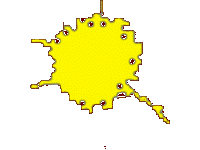  
Got something to say about this article? Want to agree (or
disagree) with it? Click the following link to go to the GUNBlast Feedback Page.
|
|
Click pictures for a larger version.
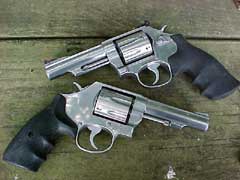
Smith & Wesson Model 620 (top) and Model 619
(bottom) .357 Magnum DA revolvers.
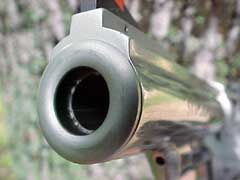
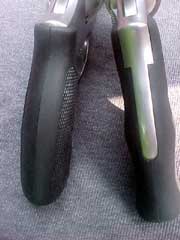
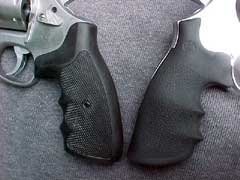
Smith & Wesson Model 619 (left) and Model 620
(right) wear rubber grips of different configuration.
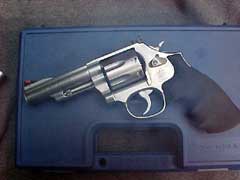
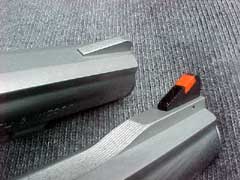
The front sight of the Model 619 (top) is a plain
stainless ramp, while the Model 620 (bottom) features a
pinned-in blue ramp with orange insert.
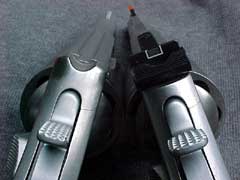
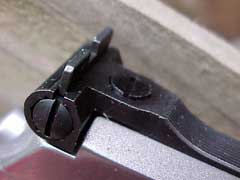
The Model 619 (left) has a fixed rear sight, while the
Model 620 (right and bottom picture) features S&W's famous
white-outline fully-adjustable rear sight.
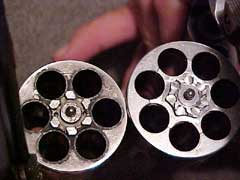
The cylinder of S&W's older Model 66 (left) compared
to the Model 620 (right). The larger diameter of the 620's
cylinder allows for an extra chamber without sacrificing
strength.
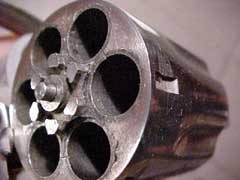
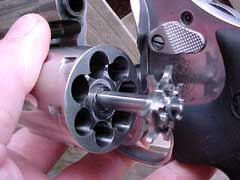
The cylinder of S&W's older Model 66 (top) compared
to the Model 620 (bottom). The older six-shot cylinder design
places the cylinder bolt cuts directly over the chambers,
reducing the minimum amount of steel in this critical stress
area, while the new seven-shot design allows the cylinder bolt
cuts to be located between the chambers.
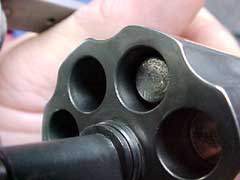
The Model 619/620 cylinder is plenty long enough to
accommodate heavier bullets, such as this 180-grain lead
semi-wadcutter.
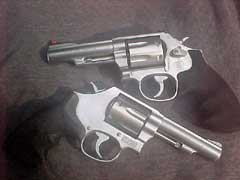
Smith & Wesson Model 620 (top) and Model 619
(bottom).
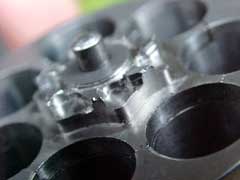
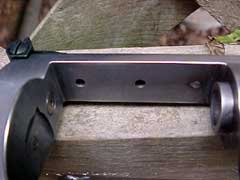
The Model 620's top strap is factory drilled and tapped
for a scope mount.
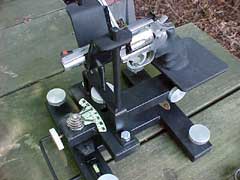
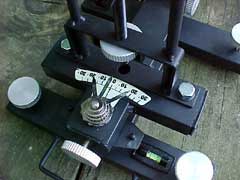
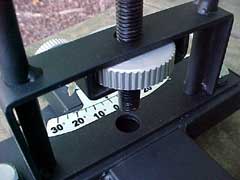
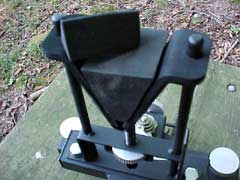
Author used a new pistol rest from Hyskore Shooting
Products for accuracy testing. The fully-adjustable Hyskore
rest is just the ticket for benchrest shooting with a wide
variety of handguns.
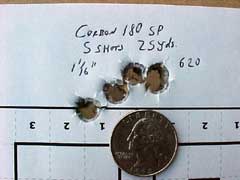
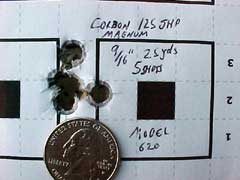
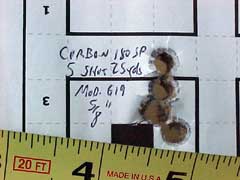
Accuracy of the Model 619 and Model 620 was much better
than Jeff has come to expect from a medium-frame service
revolver.
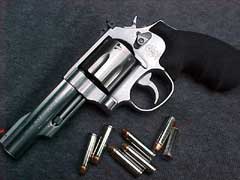
|
![]()